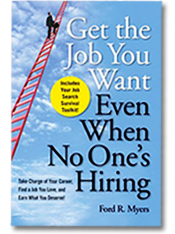Q & A With Ford R. Myers – Part 2 of 2
| Q: | What's the one job-hunting secret you share with clients that may not be widely known? |
| A: | The biggest secret I share with my clients is this: "the best way to get a new job is to never look for a job." At first glance, this statement may be a bit perplexing. What does it mean? To be blunt about it, nobody likes a job-seeker! Job-seekers are needy and annoying. They take advantage of people's time. Sometimes, job-seekers are even thought-of as "unemployed losers." Of course, none of these perceptions is generally true. What's the solution? I teach my clients to never think, act or talk like a typical job-seeker! Instead, I show them how to behave and speak like an expert, a consultant, a problem-solver. Everyone loves these kinds of folks because they add value, address challenges and bring resolution. Here's the bottom line: candidates should not look for companies to "give them a job." Instead, the enlightened candidate should seek-out opportunities to solve problems and create value. Once the candidate demonstrates his or her ability to get the to heart of a business issue and provide tangible solutions, the job is pretty much "in the bag." |
| Q: | What's the best way for job-seekers to figure out what career will give them the greatest happiness? |
| A: | It is my belief that candidates jump too quickly into the job search; and that they should spend a lot more time and energy on self-assessment. What's the point of embarking on an arduous journey, if you don't have a specific destination or know why you're departing in the first place? With this I mind, I administer several profiles with every client. The first two are "formal" career assessments (the Myers-Briggs Type Indicator and the Strong Interest Inventory). The other one is an "informal" assessment that I have developed over the past 15 years (the Career Analysis Profile). Using these three tools in combination has proved to be very powerful and effective for my clients. But the one that seems to have the most impact is the Career Analysis Profile. It's extremely gratifying to help a client get in touch with their core motivators and "drivers" – often for the first time since early childhood. Building upon the information revealed by this profile, we can develop a career path and job search strategy that moves the client toward the right opportunity for the right reasons! |
| Q: | What's the biggest mistake job-seekers make that your advice could correct or prevent? |
| A: | In my opinion, the biggest mistake a job-seeker can make is accepting an offer for the wrong reasons! In my practice, many new clients have said that they've been in their job for only three or six months, and that they're already miserable. In most cases, these individuals conducted an excellent search. They worked hard, produced outstanding results, and may even have received multiple offers. But then they sabotaged themselves "unconsciously" by taking the wrong job for the wrong reasons. What kinds of reasons? It could be … for the highest salary, or because the office was close to their home, or because they fell in love with the company's product, or even because the company had an on-site gym. Whatever the reason, one thing is clear in these cases: the person missed two essential steps: (1) To get absolutely clear, in advance, about their top professional and personal criteria for selecting a job; and (2) To commit 100 percent to those criteria, and "hold true to them" when the time came to accept the job offer. When candidates do follow these two essential steps, they avoid being "seduced" by superficial factors. Instead, they dramatically increase their chance of loving the new job; and they ensure that the position will be a great fit. And "fit" is what it's all about! |
To read the entire article, click here.
Click here to watch helpful career success videos!
